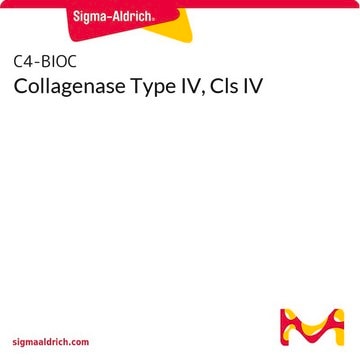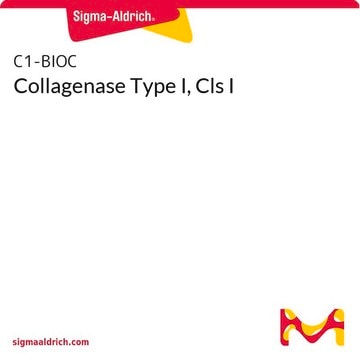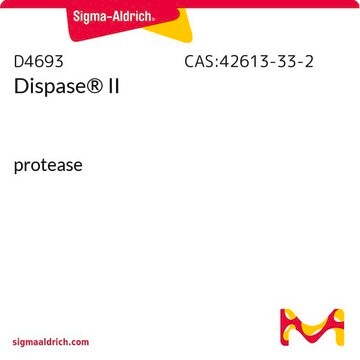The solution stability of this product has not been determined. However, other collagenase products available have been determined to be stable when stored in solution at –20°C. Repeated freeze/thaw cycles are not recommended and may result in a decline in activity. Please see the link below to review the product datasheet for C2139, a collagenase preparation for the isolation of adipocytes and hepatocytes:
https://www.sigmaaldrich.com/deepweb/assets/sigmaaldrich/product/documents/173/127/c2139pis.pdf
C2-BIOC
Kollagenase Typ II, Cls II
Synonym(e):
Collagen A
Größe auswählen
Größe auswählen
About This Item
Empfohlene Produkte
Suchen Sie nach ähnlichen Produkten? Aufrufen Leitfaden zum Produktvergleich
Allgemeine Beschreibung
Anwendung
- als Komponente von Roswell Park Memorial Institute(RPMI)-1640-Medien für den Verdau von Lebergewebe[2]
- zum Perfundieren von Mäuseherzen für die Isolierung von epikardialen Stromazellen (EpiSC)[3]
- für Verdau und Injektion der Kollagenase in die intrarenale Aorta abdominalis zur Nierenperfusion.[4]
Hier finden Sie alle aktuellen Versionen:
Analysenzertifikate (COA)
Die passende Version wird nicht angezeigt?
Wenn Sie eine bestimmte Version benötigen, können Sie anhand der Lot- oder Chargennummer nach einem spezifischen Zertifikat suchen.
Besitzen Sie dieses Produkt bereits?
In der Dokumentenbibliothek finden Sie die Dokumentation zu den Produkten, die Sie kürzlich erworben haben.
-
Dear Sir, I stored reconstituted collagenase in a -20 degrees fridge after diluting and using some of it, after 4months is the enzyme still viable for use? It was left in -20 degrees all the while, thanks
1 answer-
Helpful?
-
-
Kann die Kollagenase für die enzymatische Verdauung und Isolierung von Hühnerembryoosteoblasten verwendet werden? Wie ist die Reinheit des Produkts?
1 answer-
This product has not been tested for use in isolating osteoblasts from chick embryos. Currently, there is no collagenase product option that has been tested for suitability in this application. The product is generally used for bone tissue digests. However the end user would have to determine suitability experimentally.
A preliminary search of PubMed and Google Scholar did not find research articles citing this specific application. The working enzyme concentration range is typically 0.1 to 0.2% (w/v), depending on the delicate nature of the tissue substrate. This product is tested for enzymatic activity. The analytical purity has not been determined.
Helpful?
-
-
골관절염 모델링에 있어 collagenase type 2 를 500 U로 Intra-articular injection 해야합니다만, spec sheet 에 쓰여있는 바로는 units/mg Solid (Collagen) 이 >= 125 로 되어있는데 mg 당 정확한 unit을 알수는 없나요 ?
1 answer-
The exact value is reported on the lot specific Certificate of Analysis. Please see the link below to access a sample or lot specific Certificate:
https://www.sigmaaldrich.com/product/sial/c2bioc#product-documentationHelpful?
-
-
Dear sir I was bought collagenase before, but I can't find my instruction manual. Can I have a copy? I need to prepare 0.2% solution to dissolve tumor cells, and I want to grow solute for greenhouse configuration and two for dissolving cells.
1 answer-
Unfortunately, no user manual is provided with this product. It is recommended to prepare working solution by dissolving the enzyme in water to a final concentration of 100mg/mL. Dilute with PBS (Ca2+/Mg2+-free) to a final concentration of 1mg/mL and filter through a sterile 0.2μm membrane filter.
Another Collagenase Type II product under the Sigma-Aldrich brand, C6885, does offer a product information sheet. While the lot-specific activity between the two products varies, the storage, handling, and functional information would be the same. See the link below to review this document:
https://www.sigmaaldrich.com/deepweb/assets/sigmaaldrich/product/documents/321/500/c6885pis.pdfHelpful?
-
Active Filters
Unser Team von Wissenschaftlern verfügt über Erfahrung in allen Forschungsbereichen einschließlich Life Science, Materialwissenschaften, chemischer Synthese, Chromatographie, Analytik und vielen mehr..
Setzen Sie sich mit dem technischen Dienst in Verbindung.






